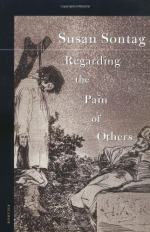
|
| Name: _________________________ | Period: ___________________ |
This quiz consists of 5 multiple choice and 5 short answer questions through Chapter 10.
Multiple Choice Questions
1. At the end of World War II, a group of journalists formed Magnum Photo Agency. Which of the following photographers was not among them?
(a) Henri Cartier-Bresson.
(b) Robert Capa.
(c) Ernst Friedrich.
(d) David Seymour.
2. Which of the following photographers exhibited photographs of Sarajevo in 1994?
(a) Jeff Wall.
(b) Larisa Shepitko.
(c) Paul Lowe.
(d) Frederick Wiseman.
3. Discussing the "co-spectatorship" and "indecency" of the image of the Vietcong suspect's execution, Sontag asserts which of the following?
(a) General Loan was unaware of the cameras at the time of the execution.
(b) The photographer arranged the execution in advance.
(c) The shooting would not have occurred in the absence of journalists to record it.
(d) The presence of journalists was an invasion of the executed man's privacy.
4. Andy Warhol silk screened which of the following images of war as his only direct statement about the atrocity of war?
(a) The raising of the flag at Iwo Jima.
(b) The death of the suspected Vietcong member.
(c) The barren wasteland of trench warfare.
(d) The mushroom cloud of the a-bomb.
5. Underneath feelings of apathy, Sontag contends are which of the following feelings?
(a) Frustration and rage.
(b) Sentimentality and despair.
(c) Anger and righteousness.
(d) Superiority and indifference.
Short Answer Questions
1. Sontag claims that compassion requires which of the following in order to remain?
2. In discussing images that remind us of death, Sontag references a particular 1943 photograph. What is the subject of this photograph?
3. The first war photographer, whose work garnered him the position as "official photographer" of the Crimean War, was which of the following?
4. Sontag lists which of the following as images that the artist "takes"?
5. Although the camera captures the scene in front of it, Sontag suggests that the ______ may manipulate the image.
|
This section contains 309 words (approx. 2 pages at 300 words per page) |

|




